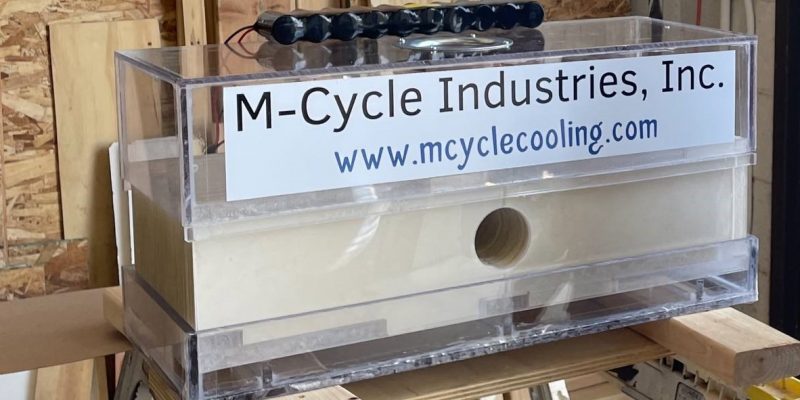This year’s winner of Airbus’s Sustainable Mobility Challenge envisions the early feasibility of evaporative air conditioners for road transport eight times more energy efficient than current systems.
Colorado start-up M-Cycle Industries backed up its forecast when it recently launched small-scale production of a proof-of-concept evaporative AC system targeted at recreational vehicles with energy consumption small enough to match for a small solar panel. In a physical test at the company, it has reached energy efficiency ratio (EER), the amount of output cooling energy per consumed energy, above 80. It also doesn’t use chemical refrigerants, driving the vehicle’s environmental impact further down.
Heating, ventilation and air conditioning (HVAC) systems have long been an unsolvable issue for EV manufacturers. “Here at the IAA, we could see an electric bus. It’s fast, comfortable and quiet, it recovers energy,” M-Cycle Industries’ co-founder and CEO Stan May told me on the phone. “However, there’s a noisy and dirty diesel generator in the back with the only mission to provide power for the cooling system.”
On a hot day’s trip around a city, an AC could cut up to 28% off the battery charge, said Kirill Sidorov, associate professor at the chair of electrical engineering and electrical equipment at Moscow Automobile and Road Construction Institute MADI. At transit buses, sometimes, consumption reaches astonishing 50%: “That’s because of the larger passenger compartment, the frequently opening doors and heat emission by the passengers.”
Virtually all state-of-the-art automotive ACs are vapor-compression systems. Their popularity is based on such virtues as compact design, reliability and low maintenance requirements. However, the principal design, developed in the 19th century, doesn’t answer the automakers’ current cry for carbon-neutral solutions. Climate systems in road transport was responsible for GHG emissions worth 420M tons in 2015 or 1% of all human-related emissions, Sidorov said. One third of that emissions comes from leakages of refrigerants such as R134A which is a strong greenhouse gas.
On the contrary, evaporative coolers use only water. However, they also come with some drawbacks which is why automakers haven’t so far been enthusiastic about them. Also, the simplest and oldest version, so called swamp cooler, is even less efficient than compression ACs while also producing only humid air. Some 50 years ago, Soviet scientist Valeriy Maisotsenko suggested an idea of separating product air channels and working air channels, raising efficiency and convenience to the new bar, giving them advantage over compression coolers and opening the way to massive use of M-cycle coolers in stationary applications.
Why we don’t see road vehicles equipped with evaporative coolers? Because of technical issues such as bulky size, high water consumption and intolerance to vehicle-specific operating conditions such as accelerations and vibration. It’s only now that a solution to these issues comes in the shape of the new generation ACs, May said. Inside the unit, one can find an intricate system of wet and dry channels and a small fan. It consumes some eleven times less water than the previous generation and is sufficiently compact to be retrofitted in a road vehicle.
It’s still a question if evaporative HVACs can become a mainstream technology in cars because of certain nuances. “M-Cycle based HVAC definitely is a solution for specific countries with hot dry air because Maisotsenko coolers gain efficiency in low humidity and high temperature,” said Hamed Sadighi Dizaji, academic and industrial researcher at the University of Adelaide. “In one case, Australia is, generally, a potentially good market for them.”
Electric buses, especially those operated in hot climates, obviously can be early birds, May suggested, because of their AC’s drastic energy needs. In this instance, energy from a roof-top photo-voltaic panel would be enough to cool down both the passenger compartment and the vehicle’s battery. A production-ready prototype could be developed in 12 to 18 months in collaboration with one of the EV manufacturers, he said.
Operating a vehicle in other climates would require certain upgrades to the basic design. For example, in humid air, the cooling unit must be combined with a desiccant module for maximum efficiency. That would increase complexity of design and energy consumption; on the other hand, such desiccant cooling system would be self-sufficient in water supply. Meanwhile, in regions with winter temperatures beyond zero, an evaporative HVAC would require its own heating module, turned on even at stops, to prevent water from freezing.
Because of existing limitations, each implementation case must be properly calculated, Dizaji said. Also, we need to verify that supply of water for the working cycle has a sufficiently small impact on the vehicle’s total carbon emissions and operating costs.
On the opposite side, the vapor-compression systems won’t succumb easily to the new rivals. Sidorov said they still can be optimized to cut energy use by theoretically possible 67% while state-of-the-art refrigerants will eventually be replaced with less hazardous alternatives. Possibly, we’re witnessing a start of the next technological race in HVACs.
by Roma Nazarov
Source: https://www.tu-auto.com




